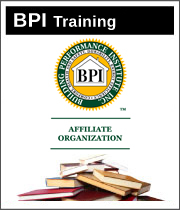Pass the BPI Exam the First Time!
FREE BPI PRACTICE EXAMBPI STUDY GUIDESA full BPI course resource for you to help pass the BPI Exam the first time!
Click for more info... GET THE NEWSLETTERTo get FREE updates and information about all the BPI Exams, please enter your name and email below.
|
BPI Field Exam - Worst Case and CAZHow To Put The House Under Worst Case ConditionsWhy worst case? Worse case conditions try to set the house up to fail so if something bad is potentially going to happen (CO getting into the home), we want it to happen while we are there so we can notify the homeowners and fix the source of the problem.
Note: even in all electric homes, if there is an attached garage, there IS a potential to bring CO into the home. Don't believe it or have a homeowner that doesn't believe it? Try leaving a car running in a closed garage and leave your CO meter in the adjacent or bonus room while the house is under worst case conditions and watch the CO meter start to raise. Yes there is a real danger of CO poisoning and you never want to have it happen under your watch. Doors closed, doors open, what's the deal?!Worse case conditions used to be having all the exhaust fans and AHU on (think of all the exhaust fans like a little blower door depressurizing or sucking the air out of the house) and interior doors closed. That is not the case anymore.
For worst case conditions in a CAZ, we want the HIGHEST NEGATIVE NUMBER, remember we want the house to fail while we are there. So we are going to use all the fans (AHU, dryer, bathroom exhaust fans, laundry room exhaust fan and kitchen exhaust fan if it goes outside) to help us create a negative... the highest negative number possible, then do our combustion tests. We need to test different scenarios with the doors open or closed to see its effect on the house pressure (by watching your manometer). If opening an interior door makes your pressure reading more negative, leave the door open. If opening an interior door makes the CAZ worst case more positive, that is working against our worst case goal (the highest negative number possible, -10 Pa is better than -2 Pa for worst case), so leave the door closed. We need to go around the house and open and close all the interior doors to see their effect on the worst case reading. Start with all the interior doors shut and windows and exterior doors closed. Turn on all exhaust fans, AHU and dryer. Now it's time to check each door. Open an interior door, then go back to your manometer and check it's reading, if it's more negative, leave it open, if it's more positive, go and close it. Then go to the next interior door and open it, go back to your manometer and check the pressure reading (in Pa, not CFM), if it's more negative leave it open, if it's more positive, go and close it. Got the hang of it? You also need to check the affect of the AHU on your worst case. This can be done at the same time as your dominant duct leakage. Dominant duct leakage is done right after you get a baseline reading with all the interior doors open, exterior doors and windows shut, all exhaust fans off and ONLY the AHU on (use high speed if new dual speed AHU). So in other words, only the AHU is on. If you get a negative dominant duct reading (more leakage on the supply), that's is good for our worst case, so leave the AHU on during worst case conditions. If you get a positive dominant duct reading (more leakage on the return), that is working against our worst case, so shut the AHU off for your worst case test. Or you can simply turn the AHU off before or after your interior door check and check your manometer, if the pressure goes down (more negative), leave the AHU on, if the pressure goes up (more positive), shut the AHU off for your worst case conditions. Accounting for the BaselineWe want a true worst case by not accounting for the baseline. You can do this by:
Now once you have the house under worst case conditions, you are ready to get your CAZ pressure readings, draft and CO tests done! How to Find Your CAZ
We need to test and
check if conditions in the home can create backdrafting, spillage or flame rollout. CAZ pressures may overcome the draft pressure needed to safely exhaust hot water tanks and furnaces. To create worst case conditions, we should turn on every device that can create a negative pressure in the house and then measure the negative pressure created where the
combustion appliance is located and compare that pressure to the outside (aka WRT outside).
How to fix a failed CAZRecommend:
Also always recommend installing UL-2034 rated CO detectors in homes with attached garages, inside the CAZ, separate detectors for each floor located 3-6 feet off the ground. Next Section |
The main topics of the BPI BA exam are listed out below. Click on a link that interests you, or you need some brushing up on to learn more on each subject.
1. Building Science Fundamentals 1a. Basic terms and definitions 1b. Principals of energy, air & moisture 1c. Combustion science 2. Buildings and Their Systems 2a. Building components 2b. Conservation strategies 2c. Comprehensive building assessment process 2d. Design considerations 3. Measurement and Verification of Building Performance 3a. Applied diagnostics and troubleshooting 4. BPI National Standards and Project Specifications 4a. Comprehensive building assessment 5. Analyzing Buildings Systems 5a. Comprehensive building assessment 5b. Appliances and lighting 6. Conduct and communications 6a. Conservation strategies |

